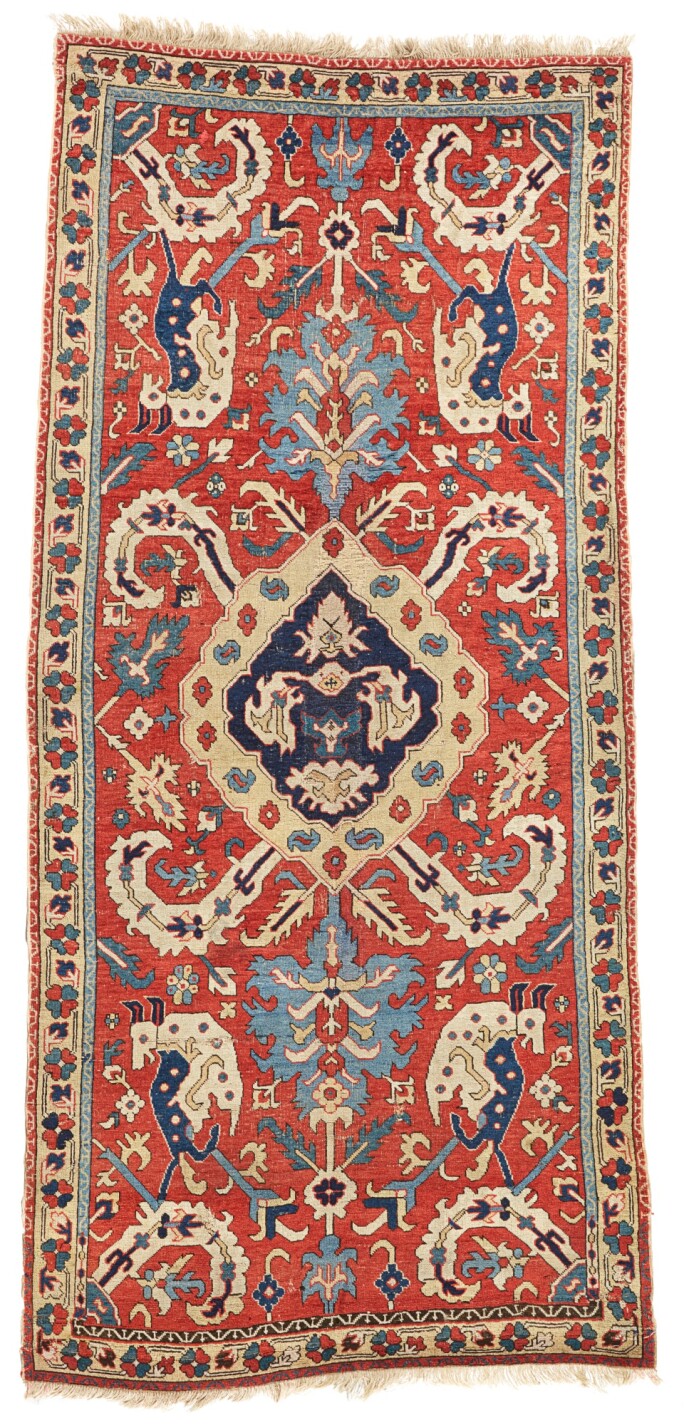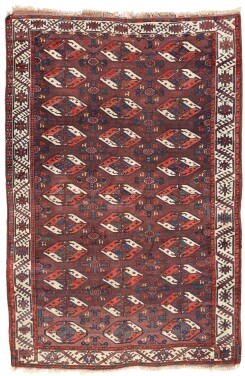M ore than fifty years after first being enchanted by a 17th-century carpet as a young boy, one collector managed to track down the very same piece – a Caucasian Animal-Combat rug – and acquire it for his own collection. Now this prized item, along with the spoils of a lifetime of collecting carpets, are being sold at auction, A Passion for Collecting: The Rugs and Carpets of a Connoisseur, to be held in London on 27 November.
The exquisite catalogue, all belonging to this single owner, demonstrates his life-long interest in the discipline and encompasses an extraordinary variety of weaving techniques, periods, cultures and forms, a fascination with which was first sparked by accompanying his mother to visit one of the most renowned European Rug and Carpet dealers, Dr. Ulrich Schürmann in Cologne.
Dr. Schürmann was synonymous with high quality and collectible rugs and carpets. Born in 1908 in Essen, he trained as a lawyer, and was a golf and Cresta Run aficionado. He was introduced to the industry by his father who, along with his three brothers, ran a store devoted to interior decorations, furniture and textiles. His father specialised in oriental rugs and in 1950, Dr Schürmann himself opened an office in Cologne to deal in rugs. He and his wife worked to revive the popularity of the oriental rug as a work of art, against a post-war backdrop when the rug trade was considered a ‘thief's trade’. In an attempt to create a new kind of dealer and forge strong relationships with clients, he offered good value and inspired in them a deep love for the art of rug-making, becoming one of the most important dealers of the time. It was in his shop that the collector behind Sotheby’s upcoming sale fell in love with the art of rug weaving, remembering crawling across the beautiful carpets and counting their knots as his mother explained the patterns.
Highlights from the sale
Today, the collector’s broad interests in collecting art extend to Renaissance, Baroque, 18th, 19th and 20th century with Classical Modern, German Expressionism and Post-War as well as Contemporary Art, and this is reflected in the wide-ranging rug and carpet collection being offered at auction.
Weavings From The Caucasus
The Caucasus refers to the strip of land flanked by the Black and Caspian seas, and comprises modern-day Georgia, Armenia, Azerbaijan and the south-westernmost tip of Russia. Historically home to both nomadic tribes and more densely populated trade towns and cities, both became famous for their prized, colourful weavings.
Shah Abbas (r.1587-1629) established weaving workshops in the Shirvan and Karabagh provinces, and early production included large scale ‘Dragon’ and ‘Blossom’ carpets. Classical Persian and Ottoman courtly weavings, both carpets and textiles, provided the design inspiration, which is particularly clear in both the 17th century Animal-Combat carpet in the sale and the late 18th/early 19th South Caucasian rug with the Cheleberd medallion and the Azerbaijan gallery carpet, which reveal how fertile these aesthetic exchanges were in the region.
By the mid-19th century, multiple regionalised variations in technique and designs had developed, and the striking and richly coloured weavings of the Caucasus became highly collectible throughout Europe and America. The advent of chemical dyes in the late 19th century, brought arguably less harmonious colours, and more commercialised weaving with standardised patterns.
This sale includes 19th century examples of several of the best-known Caucasian weaving models, from bold graphics to quirky production to finer, more delicate weaves.
Tribes Of The Turkmen
Semi-nomadic pastoralists from the region east of the Caspian and south of the Aral Sea, in what is mainly present-day Turkmenistan, have occupied this region for more than 1,000 years. Makhmud Kajari, listed 22 Oguz-Turkic tribes inhabiting the Amu Darya/Syr Darya Delta in his 11th century work Lugat-at-aturk.
This sale includes Turkman weavings dated to the 17th and 18th century, as well as the more usual 19th-century examples; amongst these are a rare and important Eagle-Gul Group 1 carpet. Tribes represented include the Saryk, the Chador, the Yomut and the Tekke, and several formats in which the weavers displayed their skills, including bags (mafrash and torba), a bridal camel trapping and a good Yomut engsi, (the rug used as a door curtain to the yurt).
Turkish Rugs In Transylvania
The fact that nearly 400 classical Ottoman rugs survived in the Lutheran Evangelical churches and museums in Transylvania is a unique cultural phenomenon. This is still the most important collection of Anatolian textiles outside the Islamic World, dating from the 15th to 18th century, a time when Ottoman textile production was at its peak.
This rich repository includes many of the classic types such as ‘Holbeins’, Oushaks including ‘Star’ Oushaks, ‘Lottos’, Selendis (‘Bird’ rugs), as well as the so-called ‘Transylvanians’, many in astonishingly good condition.
Between the 16th and 17th centuries, Transylvania was an autonomous principality of the Ottoman Empire, under Hungarian rule and situated at an important trade route between East and West. Anatolian rugs were traded in large numbers and were appreciated as objects of high value and prestige.
At the same time, with the Reformation, Ottoman rugs became suitable decoration for Reformed churches in Transylvania when most of the Catholic imagery was erased or whitewashed; they were donated by parishioners to adorn the austere church walls and pews, as signs of gratitude, in memoriam, or as symbols of wealth and stature.
Some of the finest pieces preserved in the Transylvanian Churches and Museums are classic Oushak rugs such as the ‘Star’ Oushak example in this sale. They were traditionally produced in the region of Oushak in Western Anatolia as early as the late 15th century. These were the first rugs to be woven for the European market, where they were very popular during the Renaissance and Baroque periods, as featured in many paintings of distinguished artists of the time.
The term ‘Transylvanian’ for some of these rugs was coined in the 20th century, however, in relation to a specific family of weavings that survived within the Transylvanian region. Produced in several areas of West Anatolia, these rugs are typical for 17th-century Turkish weaving, incorporating design elements taken from architecture and motifs seen in earlier Oushak rugs, Ottoman court textiles or Iznik ceramics.
The ‘double-niche’ rug, of which lot 87 is a wonderful example, is one of the four main designs traditionally attributed to the ‘Transylvanian’ group. There is speculation that this format was created following an edict issued by Sultan Ahmed I in 1610, banning the sale of rugs with depictions of mihrab, kaaba and religious script to non-Muslim countries. The ‘double-niche’ rug represents, therefore a mirrored, adapted version of the prayer rug with its ‘single-niche’ design.
















